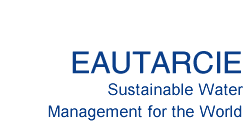
EAUTARCIE’S ECOSAN, called SAINECO, is one of the EAUTARCIE concepts relative to sustainable wastewater management. This demands relinquishing all-mains sewerage and replacing it by the selective (separate) treatment of each type of wastewater.
To visualize the general schematic of the TRAISELECT system, click here![]() .
.
The text within this page was first published in French on www.eautarcie.com: 2005
The text has been adapted and translated in English by André Leguerrier and was first published on this page: 2009-06-15
Last update: 2016-10-25


EAUTARCIE's ECOSAN in an Urban Setting
Centralized Wastewater Treatment
In the present state of affairs, technically and legally, centralized wastewater collection and treatment seem to be inescapable in urban centres. Yet, the adverse environmental impacts of conventional sanitation could be reduced by applying an integrated approach to sanitation known as ecological sanitation.
One of the first measures to be taken is to subdivide the city in smaller units, for wastewater collection and treatment. The aim is to avoid as best the discharge of treated wastewater directly into a watercourse.
A neighbourhood’s wastewater issuing from a specifically adapted sanitation plant would not be discharged in a watercourse, but in a wetland that is designed for this purpose. Its subsequent exposure to air, and light (that we have coined photo-purification) would complete its treatment before the water’s discharge in the closest river. Such wetlands could breathe new life to cities and provide refuges for migratory birds. You could even consider harnessing plant biomass from periodic harvesting of coppice crops planted in the wetland for this purpose.
I can already anticipate objections concerning the lack of available space in cities. Yet when one wants to find a solution, one inevitably finds it: but, you need to want to...
Towards Sustainable Sanitation
Contrary to popular belief, truly sustainable sanitation is possible by applying all the principles of EAUTARCIE’s version of ECOSAN, thus paving the way to cities that no longer pollute water
Those who regard the « all-to-the-sewer » concept as inescapable will doubtless find my reasoning utopian. I will however attempt to demonstrate that the solutions proposed herein constitute a set of technical applications that have already proven themselves, and as such, generate possibilities that are far from utopian.
It is nonetheless true that various attempts and experiments have been made to realize city neighborhoods applying water management principles that are more rational than all-mains sewerage. Ingenious attempts to treat water with plants sometimes display surprising results: apartment buildings whose facades are covered with water-purifying plants. Others have tried using self-contained systems using soil as a filter to purify water, but without infiltrating water to replenish ground waters. These exhibit variable results, usually taking up significant space at a relatively important cost.
The common ground to all these attempts is the will to purify water as much as possible. When you consider the overall environmental impact of city wastewater production and treatment, water pollution actually only represents a minor aspect of the problem. A greater concern remains shamefully neglected: the destruction of biomass under pretence of wastewater purification. Remember that domestic and agri-food wastewater is not waste, but constitutes a precious and fully recyclable resource. For a sustainable world, there is no other way.
We suggest that the notion of purification efficiency be replaced by a more comprehensive one, that of environmental performance. From that point on, you come to realize that water purification cannot remain the ultimate goal, but that reducing environmental damage or even regenerating the biosphere is a more fundamental target. The other neglected aspect of the problem is the breakdown of Nature's great natural cycles (i.e. carbon, nitrogen, phosphorous, and even water) due to urban activities.
The main objective of sustainable sanitation must be to renew domestic activities within Nature's great cycles. To take heed of these cycles, we must intervene on two fronts:
- Instead of destroying the organic matter contained in black water, by means of its treatment, we must include this organic matter in a vast integrated management program for biomass conservation and renewal. This starts with integrated management of fermentable household waste, plant waste and cellulose-containing urban waste. In so doing, we will repair the damage that has resulted from the breakdown of carbon, nitrogen and phosphorous cycles, inflicted by domestic activities over the years.
- Instead of collecting household wastewater and sending it to a sanitation plant for treatment, after which it will be sent back into the closest river, all effort must be made to restore the natural soil moisture regime by means of more sustainable measures. This will help uphold the water cycle within man-made urban environments [1].
Water consumed by a city's inhabitants, and discharged – after treatment – back into the closest river is equivalent to drawing from our water reserves a quantity of water equal to that of a small river. For example, wastewater issuing from a city of about 100 000 inhabitants, equivalent to 180 litres per day per person, represents 12.5 m3 per minute.
Separate Greywater and Black Water Collection
In a perspective of ecological sanitation, we must abandon all-mains sewerage. The key to this approach is to collect and treat grey and black wastewater separately.
The transition to such a concept is undeniably problematic in existing built city neighbourhoods. The main impediment comes from the absence of separate stormwater and sanitary sewers, obliging the placement of an additional network of sewers specifically for sewage and the modification to building drainage outlets to separate the outflow of both types of domestic wastewater (greywater and black water). That's why it should immediately be mandatory to install separate drainage outlets in all new constructions, setting the stage for the selective collection and treatment of each type of wastewater, an unavoidable option in a future that is not far off.
Interestingly, many cities are currently implementing separate sewerage networks, although not for ecological sanitation purposes. Their aim is to avoid diluting sewage with stormwater. By collecting and conveying stormwater separately, sanitation plants will not have their sewage treatment processes disrupted by major rainfalls. Thus, implementing separate sewer systems currently has the seal of approval from sanitation engineers.
We suggest somewhat the same thing, although not for sewage and stormwater, but rather for sewage and greywater. As for stormwater, we recommend that it be totally retrieved and stored in tanks to be located near or under buildings [2]. Street and road stormwater – not containing faecal matter – can be conveyed in the greywater sewerage network. In already-built urban communities, the existing sewerage network will serve this purpose, as it will no longer receive any black water. To summarize, greywater and roadway stormwater will be collected by the existing sewerage network, whereas black water will be collected by a new and separate sewerage network.
By complying with PLUVALOR standards, i.e. 16 m³ storage capacity for each 100 m² of horizontally measured roof catchment area, a city's cisterns would represent the equivalent of an enormous storm-water tank. Instead of rushing into the sewerage network and flushing its pollutant load towards the river, storm-water would be held in the cisterns to be gradually released to the greywater conveyance network, in proportion to domestic greywater production.
Selective Treatment of Black Water
Applying the BLT Principle
A growing part of the world population lives in cities where dry toilets cannot be envisaged. In fact, urbanization is intensifying. The heart of the problem can therefore be resolved through city-based solutions.
Contrary to popular belief amongst dry toilet users (and some environmentalists), people in cities would continue to use flush toilets, but of the low-flow kind. Flush toilet effluent would be separetely collected and thereafter treated in specifically adapted impregnation and composting centres. This solution is equivalent to using a gigantic BioLitter Toilet (BLT), or by extension, applying the BLT Principle. The convenience of flush toilets is maintained, without sacrificing the environment.
Pursuant to ongoing experiments with the compost boiler, it turns out that water from (low-flow) toilet flushes is required to impregnate cellulosic litter made up of green waste, prior to composting.
Integrated Biomass Treatment Centre
Flush toilet effluent (black water) that will have been discharged in a separate sewerage network or into a septic holding tank will be conveyed/hauled to an integrated biomass treatment centre. Installations of this type already exist [4].
In Brittany (France), there already are 6 impregnation/composting centres like TRECOFIM, recycling either human waste or livestock manure. The impregnated litter (with a correct carbon/nitrogen ratio of 60) practically does not smell. When dealing with large stocks of litter, composting can be accelerated by using machinery that periodically turns and aerates the heap during the process. Other techniques are available. For example, I have visited a treatment centre that combines pig slurry (liquid pig manure) with litter made up of shredded green city waste. During composting, air is injected by means of a compressor, boosting the temperature of the compost heap to 90°C, such that care needs to be taken to prevent the heap from coming to a blaze. After 3 weeks of this treatment, the compost has cured. It is then screened, bagged and sold in big-box garden centres.
The biomass treatment centre's importance relies on an integrated management of many types of waste that combine concentrated black water (and/or pig slurry) with cellulose and organic waste from many sources: for example, the fermentable part of domestic waste, and also its cellulose component (cardboard, paper waste) [5]. The treatment centre can also include other waste in the recycling process: organic plant waste from city park and tree maintenance, seasonal leaf and yard waste collection, etc. – and to a certain extent –rural, agricultural and forestry waste [6] and agri-food industry waste.
Many municipalities already collect city waste selectively, specifically for recycling or composting. Most collection covers glass, paper and plastics. We feel that the most important waste that should be collected is fermentable domestic waste (about 45% of garbage) and cellulose-based domestic waste. These are without a doubt the most precious components of urban waste. Besides cardboard, cellulose also includes soiled paper that is impossible to recycle as paper.
Resorting to forestry waste combustion (in the form of compressed wood fibre pellets) for furnaces and boilers is an unforgivable environmental wastage that undermines the biosphere. This cellulose waste is an important component of the natural carbon cycle. It is an innate and indispensable complement to industrial pig manure production – in so much as we insist on maintaining such an aberration. A biomass treatment centre should not only integrate dejecta from livestock farming, but also wood and cardboard waste from millwork shops, packaging and construction industries. After shredding, these are ideal cellulose substrates for animal and human manure. The most logical use for forestry by-products such as wood fibre pellets is heat production not by combustion, but by composting using the Jean Pain method. In this way, wood pellets would produce almost as much energy as combustion, but instead of being reduced to ashes (with the inherent CO2 emissions), they would produce highly valuable compost for agriculture.
The treatment centre's end product will be cured compost, an ideal organic soil amendment for fertilizing and especially regenerating agricultural land that has been destroyed by a century of intensive (chemical dependent) farming. Integrated biomass treatment centres will become the sustainable management hub of our environment [7].
The resulting compost will rapidly become a vector of farmland soil regeneration and fertilization. Synthetic fertilizing needs will drop. Remember that it takes 2.5 kg of petroleum to manufacture 1 kg of chemical fertilizer, plus the pollution involved not only in its production but also by its use. A progressive increase in soil's humus content will also entail a reduction in the need for synthetic pesticides and herbicides.
In peri-urban and single family housing neighbourhoods
In peri-urban and suburban neighbourhoods where single-family homes usually have a garden (called a « backyard » in North America), it would be better to promote good dry toilets (like the BLT). Families who absolutely insist on the convenience of a (low-flow) flush toilet will then need to install a septic holding tank for toilet effluent (representing only 20% of current domestic wastewater), to be conveyed/hauled to a biomass treatment centre (for impregnation of cellulose litter and subsequent composting) or to be hauled to the garden, in a bed of plant-based litter somewhere in a corner of the garden.
Selective Treatment of Greywater
Technical solutions differ for different urban contexts, between already built and not yet built urban communities, and within single family housing neighbourhoods.
To uphold the water cycle, it is best to avoid resorting to greywater sewerage networks in neighbourhoods where there is sufficient land to allow greywater infiltration into the soil. For roadway stormwater collection, there could be a system of drainage gutters and/or covered chases (e.g. topped with perforated concrete covers, grates, etc.). These should not be watertight, just as the greywater conveyance network itself need not be watertight. From there, roadway stormwater should be conveyed through densely vegetated humid areas before re-entering a watercourse.
In already-built urban communities
Greywater collection is really only necessary in high-density urban communities. For simple greywater (black water being collected separately), you can resort to existing sewers. However, the sanitation plants to which these sewers are connected are inappropriate for greywater treatment: they need to be adapted for greywater,and in fact simplified.
Under the fifth principle of EAUTARCIE’s ECOSAN, it is essential not to discharge greywater – treated or untreated - into a watercourse. For this, wastewater treatment plants that are specifically adapted for greywater will discharge treated water into designated wetlands to be located in the urban periphery. These wetlands would become stopovers for migratory birds. Only after having gone through these wetlands will the treated wastewater finally be discharged into a watercourse. Experience has shown that daylight plays a key role in clarifying these waters, that we have coined « photo-purification ». Soap and detergent micelles tend to coagulate and settle on the bottom. The resulting sludge is then transformed by bacteria that decompose the sludge into water and carbon dioxide.
In not-yet-built urban communities
To prepare for the future – and at the same time make significant savings – regulatory measures need to be taken immediately. New constructions must be obligated to include separate black water and greywater drainage networks /outlets, in anticipation of when separate sewerage networks will be (unavoidably) implemented. Such measures should even be extended to new constructions everywhere.
In newer neighbourhoods, all greywater produced by urban households could be recycled, after proper screening, oil removal and sedimentation, to be used to recharge ground waters or irrigate food crops, without any health risk. In dry or desert areas, this is a must.
In peri-urban and single family housing neighbourhoods
In peri-urban and suburban neighbourhoods where single-family homes usually come with a garden, there are simpler solutions that are less expensive and more efficient to protect the environment.
To continue reading, go to chapter on EAUTARCIE in developing countries.




